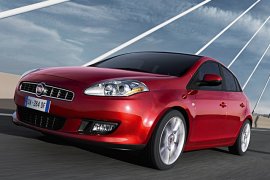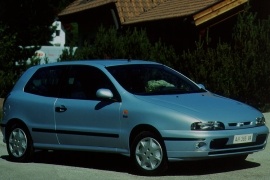FIAT Bravo Models/Series Timeline, Specifications & Photos
First production year: 1995
Engines: Gasoline, Diesel
Body style: Hatchback
The Italian automaker made its move into the European compact segment and introduced the second generation of the Bravo in 2007, bringing styling to a table where everyone else tried to convince customers with their technical advantages.
Unfortunately for the Italians, 2007 marked the beginning of the world financial crisis, which bit deep into the automakers' pockets. Fiat already had some troubles, hoping their cars would do well. But all of a sudden, the market shrunk.
Designed by Fiat's own styling center, the Bravo showed a front fascia with swept-back headlights that resembled some of those installed on supercars. Moreover, the slim upper grille and the sporty-looking bumper with side scoops and foglamps made a good impression. From its profile, the ascending beltline towards the C-pillars and the blackened B-pillar tried to convince customers that it is a sporty compact hot-hatch, even if it wasn't fitted with a powerful engine.
Inside, the dashboard design took inspiration from the sporty vehicles built by Alfa Romeo. At the same time, the tall center console created a cocoon-like feeling for the driver. In addition, Fiat offered as an option a performant infotainment unit with sat-nav and touchscreen. The bolstered bucket seats at the front were comfortable. Their higher-mounted position allowed the carmaker to create better legroom for the rear-seat passengers. At the back, the split-folding bench allowed customers to increase the trunk space when needed.
Under the hood, the carmaker offered a wide engine range, gasoline and turbo-diesel. Apart from the base model, all other units were turbocharged and provided enough oomph and Italian feeling for their drivers. The six-speed manual was standard on the entire range, while selected versions received a six-speed automatic.
Fiat replaced the Tipo range in 1994 not with one but with two cars named differently but sharing the same platform: the Bravo and the Brava.
But it was a marketing trick: it was the same vehicle in three and five doors, respectively. While Bravo was the sportier-looking model, the Brava was the family guy. Compared to the older Tipo, it was a significant leap forward in terms of quality and engineering, at a price that could threaten the Golf. In fact, it was that good that it won the 1996 European Car of the Year award.
Its rounded-shaped bodywork was a far departure from the wedged-shaped Tipo. It was the bio-design era, and the Italians did a great job at that. Despite its narrow headlights and the tiny grille above cut on the hood's front end, it had its appeal. To help cool the engine, the carmaker added a wider grille on the lower part of the bumper. Its rear quarter panels featured an enlarged area above the rear wheels, creating a muscular appearance. Unlike other cars available with three and five doors, the Bravo featured a different set of taillights than its five-door sibling Brava.
Inside, the designers continued the bio-design styling with rounded shapes and curved surfaces. The center stack incorporated the audio system on the upper side. Inside the instrument panel, Fiat installed a four-dial layout with the speedometer and tachometer in the middle, flanked by the fuel gauge on the left and the coolant-temperature indicator on the right.
Under the hood, Fiat installed a wide engine choice, 80 hp, and 154 hp. The latter was offered on a limited edition Abarth. Still, the 2.0-liter HGT that provided 147 hp was almost as potent and available since the car's launch until late 1999, when the Bravo/Brava duo received an update for the Euro 3 emission standards.

